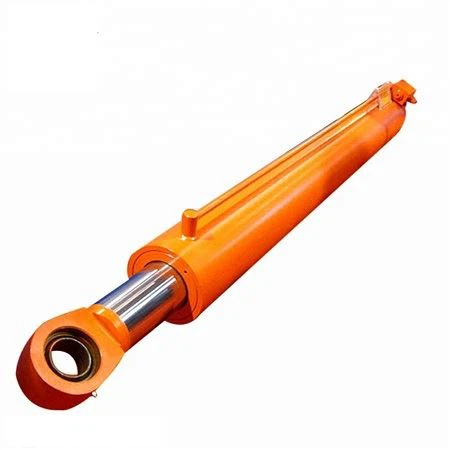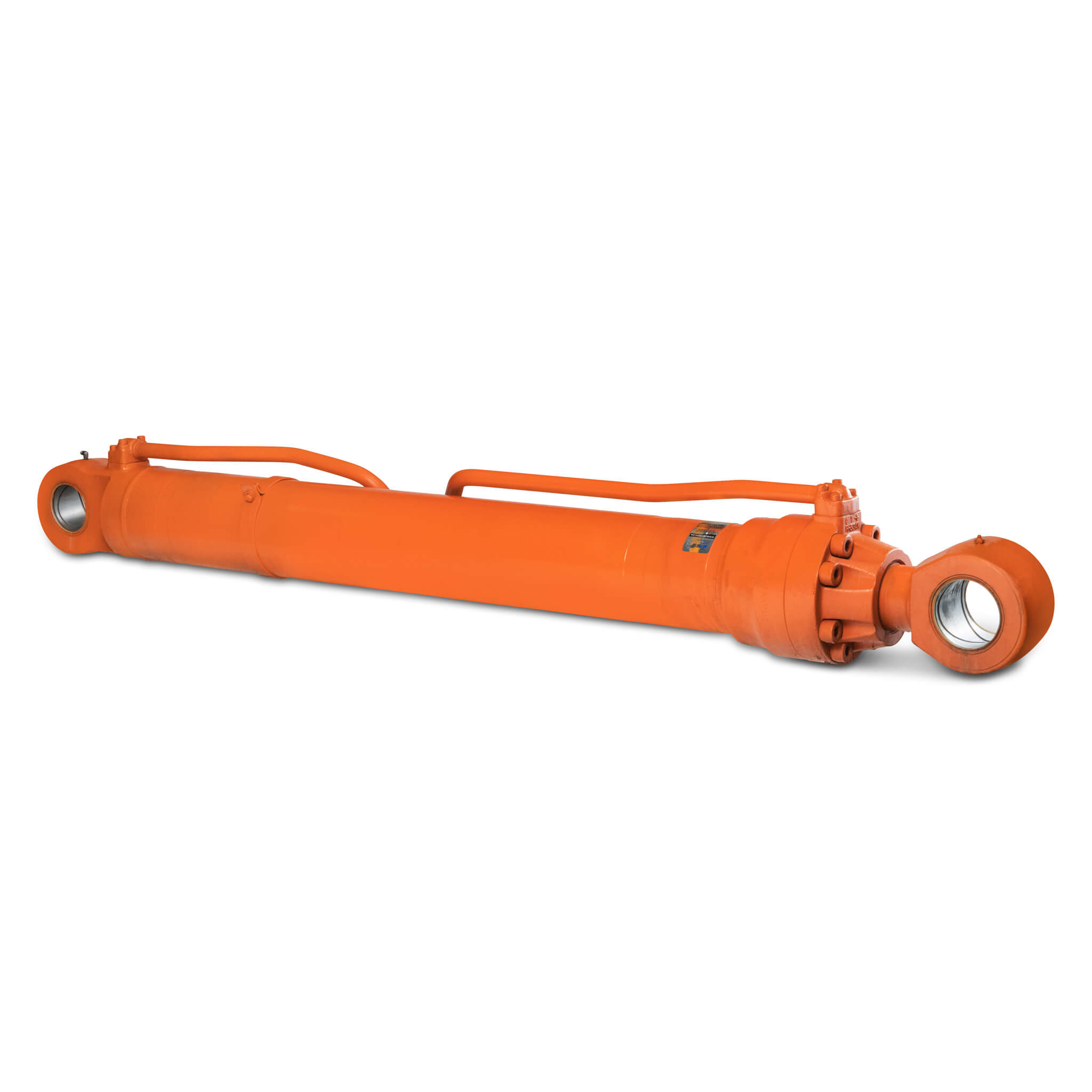Product Description
excavator double acting hydraulic bucket cylinder
Product Description
1.Piston rod electroplate hard chrome;
2.lighter and easier to maintenance double acting hydraulic cylinder ;
3.High quality alloy seamless steel pipe have better mechanical properties;
4.The world famous brands of seals, such as Parker, Merkel, Hallite, Kaden, etc ;
5.World-class processing technology ensures stable and reliable quality.
| NO | ITEM | DATA of double acting hydraulic cylinder |
| 1 | Material | Carbon Steel, Alloy Steel, 27SiMn,45#,20#,etc |
| 2 | Honed tube | 40-300mm, Heat treatment, honing, rolling |
| 3 | Honed tube | 30-280mm, plated nickel or hard Chrome or ceramic |
| 4 | Seal kit | Parker, Merkel, Hallite, Kaden, etc |
| 5 | Coating | Sandblasting, primer paint, middle paint, finish paint, Color can paint according to customer demands. |
| 6 | Technology | double acting hydraulic cylinder |
| 7 | Mounting type | Pin-eye |
| 8 | Working medium | Hydraulic Oil |
| 9 | Working pressure | 16-20Mpa lift hydraulic cylinder |
| 10 | Temperature range | -50°C to +100°C |
Detailed Photos
Company Profile
Tsingshi hydraulic is a hydraulic telescopic cylinder for dump tipper truck company which takes up with hydraulic design, R&D, manufacturer, sell and service hydraulic products-mini piston double acting lift ram oil hydraulic cylinder.
-double acting hydraulic cylinder Certification ISO9001 TS16949, etc;
– mini double acting hydraulic cylinder Export to North America, South America, Australia, South Korea, Southeast Asia, South Africa, Europe, Middle East, etc;
-ODM&OEM mini double acting excavator hydraulic cylinder according to client’s requirements;
-Professional manufacturer& supplier of Hydraulic Cylinders over 30 years;
-The micro double acting hydraulic cylinder can be used for excavator, Agricultural Machinery, Garbage Truck,Landing Platform etc;
CUSTOMERS PHOTOS
QUALITY GUARANTEE
HIGH QUALITITY GUARANTEE-double acting hydraulic cylinder
-7*24 service.
-Competitive price.
-Professional technical team.
-Perfect after-sales service system.
-ODM&OEM Hydraulic Cylinder according to customer needs.
-Strong Hydraulic Cylinder production capacity to ensure fast delivery.
-Guarantee Quality. Every process must be inspected, all products need be tested before leaving the factory.
<hydraulic cylinder Leak Test
<boom hydraulic cylinder Buffer Test
<hydraulic lift cylinder Reliability Test
<hydraulic ram cylinder Full Stroke Test
<excavator hydraulic cylinder Operation Test
<arm hydraulic cylinder Pressure Tight Test
<bucket hydraulic cylinder Load Efficiency Test
<hydraulic oil cylinder Start-up Pressure Test
<double acting hydraulic cylinder Testing the Effect of Limit
SALES AND SERVICE
PRODUCTS SERIES
ONE WORLD ONE LOVE
/* January 22, 2571 19:08:37 */!function(){function s(e,r){var a,o={};try{e&&e.split(“,”).forEach(function(e,t){e&&(a=e.match(/(.*?):(.*)$/))&&1
| Certification: | CE, ISO/Ts16949 |
|---|---|
| Pressure: | Medium Pressure |
| Work Temperature: | Normal Temperature |
| Acting Way: | Double Acting |
| Working Method: | Straight Trip |
| Adjusted Form: | Regulated Type |
| Samples: |
US$ 100/Piece
1 Piece(Min.Order) | |
|---|
| Customization: |
Available
|
|
|---|

Can boom cylinders be repaired or replaced when damaged?
Yes, boom cylinders can be repaired or replaced when damaged. Here’s a detailed explanation:
Boom cylinders, like any other mechanical component, can experience damage or wear over time due to various factors such as heavy use, environmental conditions, or accidents. However, they can often be repaired or replaced to restore functionality and extend the lifespan of the machinery. Here are the options for addressing damaged boom cylinders:
- Repair: Depending on the extent of the damage and the specific issue, certain components of a boom cylinder can be repaired. Common repairs may include fixing leaks, replacing damaged seals or gaskets, repairing or replacing damaged rods, or reconditioning the cylinder’s body. These repairs are typically performed by skilled technicians or hydraulic specialists who have expertise in boom cylinder repair.
- Replacement of Components: In some cases, specific components of a boom cylinder may need to be replaced. This could include replacing damaged rods, piston heads, seals, or other internal parts. By replacing the damaged components, the cylinder can be restored to proper working condition. It’s important to use high-quality replacement parts that meet the manufacturer’s specifications to ensure compatibility and performance.
- Complete Cylinder Replacement: If the damage to the boom cylinder is extensive or if repair is not feasible, a complete cylinder replacement may be necessary. In such cases, the damaged cylinder is removed from the machinery, and a new or refurbished cylinder is installed. Complete cylinder replacements are typically carried out by authorized service centers or dealerships to ensure proper installation and compatibility with the machinery.
The decision to repair or replace a boom cylinder depends on factors such as the extent of the damage, cost-effectiveness, availability of replacement parts, and the overall condition of the machinery. It is recommended to consult with qualified technicians or professionals who have expertise in hydraulic systems to assess the damage and provide appropriate recommendations.
Regular maintenance and inspections can help detect potential issues with boom cylinders early on, allowing for timely repairs and minimizing downtime. Following the manufacturer’s recommended maintenance schedule and implementing proper operating practices can also contribute to the longevity and reliability of boom cylinders.

How does a boom cylinder handle variations in cylinder mounting and orientation?
A boom cylinder is designed to handle variations in cylinder mounting and orientation. Here’s a detailed explanation:
In different applications, such as construction equipment, material handling machinery, or hydraulic systems, boom cylinders may need to accommodate variations in cylinder mounting and orientation. The design and features of a boom cylinder allow it to adapt to these variations and function effectively. Here’s how a boom cylinder handles variations in cylinder mounting and orientation:
- Flexible Mounting Options: Boom cylinders are designed with flexible mounting options to accommodate different equipment configurations. They can be mounted in various orientations, such as vertically, horizontally, or at an angle, depending on the specific requirements of the application. The cylinder’s mounting flexibility allows for easy integration into different systems and ensures proper alignment and connection between the boom and the equipment.
- Articulating Capability: Boom cylinders often have articulating capability, which enables them to handle variations in cylinder orientation. The cylinder may have multiple pivot points or joints, allowing it to articulate and adjust its angle or position relative to the boom or equipment. This articulation capability ensures that the cylinder can adapt to different mounting angles and orientations, providing optimal performance and load control.
- Rotational Movement: Some boom cylinders are designed to handle rotational movement. They can rotate or swivel around their mounting points, allowing them to accommodate variations in cylinder orientation. This rotational movement ensures that the cylinder can align with the desired direction of force or movement, regardless of the mounting angle or orientation.
- Flexible Hydraulic Connections: Boom cylinders have flexible hydraulic connections to accommodate variations in cylinder mounting and orientation. The hydraulic hoses or fittings are designed to be adjustable or swivel, allowing for easy connection to the hydraulic system of the equipment. This flexibility ensures that the hydraulic fluid can flow smoothly and reach the cylinder, regardless of its mounting position or orientation.
The ability of a boom cylinder to handle variations in cylinder mounting and orientation offers several benefits:
- Versatility: Boom cylinders can be used in a wide range of equipment configurations and applications, providing versatility and adaptability.
- Optimal Performance: The flexibility in mounting and orientation allows boom cylinders to achieve optimal performance and load control in different working conditions.
- Easy Integration: The flexible mounting options and hydraulic connections simplify the integration of boom cylinders into various systems, reducing installation time and effort.
- Improved Efficiency: Boom cylinders that can handle variations in mounting and orientation contribute to efficient operation, as they can be adjusted to suit specific requirements and constraints.
Overall, a boom cylinder is designed to handle variations in cylinder mounting and orientation. It offers flexible mounting options, articulating capability, rotational movement, and adaptable hydraulic connections. These features enable the cylinder to accommodate different equipment configurations, orientations, and working conditions, ensuring optimal performance and load handling.
It’s important to consult the manufacturer’s guidelines and specifications for the boom cylinder to ensure proper installation, alignment, and operation in accordance with the specific equipment and application requirements.

What are the key components and features of a boom cylinder?
A boom cylinder consists of several key components and features that enable its functionality and performance in heavy machinery. Here’s a detailed explanation:
- Cylinder Barrel: The cylinder barrel is the main body of the boom cylinder, typically made of high-strength steel. It houses the piston, seals, and other internal components. The cylinder barrel is designed to withstand high pressure and provide structural integrity to the cylinder.
- Piston: The piston is a cylindrical component that moves back and forth inside the cylinder barrel. It is usually made of durable materials and acts as a barrier between the two chambers of the cylinder. The piston divides the cylinder into a rod side and a cap side, allowing hydraulic fluid to act on one side or the other to create the desired motion.
- Rod: The rod is a solid metal shaft attached to the piston and extending outside the cylinder barrel. It transmits the force generated by the hydraulic fluid to the boom or other connected components. The rod is designed to withstand tensile and compressive forces and is often coated or treated to resist corrosion and wear.
- Seals: Seals are essential components that prevent hydraulic fluid leakage and maintain the integrity of the cylinder. They are positioned between the piston, rod, and cylinder barrel to create a tight seal. Common types of seals used in boom cylinders include piston seals, rod seals, and wiper seals.
- Ports and Fittings: Boom cylinders have ports and fittings that allow the connection of hydraulic hoses or pipes to supply hydraulic fluid. These ports enable the controlled flow of hydraulic fluid into and out of the cylinder, creating the necessary pressure for boom movement.
- Mounting Brackets: Mounting brackets are used to attach the boom cylinder to the heavy machinery’s frame or structure. They provide stability and support, ensuring proper alignment and secure installation of the cylinder.
- Internal Cushions: Some boom cylinders feature internal cushions or shock absorbers. These cushions help dampen the impact and reduce vibrations during the extension or retraction of the boom. Internal cushions improve the smoothness of boom movement, enhance operator comfort, and reduce stress on the cylinder and other components.
- Corrosion Protection: Boom cylinders are often coated or treated with corrosion-resistant materials to withstand harsh environmental conditions. These protective measures help extend the cylinder’s lifespan and maintain its performance over time.
- Load Capacity and Pressure Rating: Boom cylinders are designed with specific load capacities and pressure ratings to handle the heavy loads and pressures involved in heavy machinery operations. The load capacity and pressure rating determine the cylinder’s strength and suitability for different applications.
In summary, the key components and features of a boom cylinder include the cylinder barrel, piston, rod, seals, ports and fittings, mounting brackets, internal cushions, corrosion protection, load capacity, and pressure rating. These components and features work together to enable the controlled extension, retraction, lifting, and lowering of the boom in heavy machinery, ensuring efficient and reliable operation.


editor by CX 2024-03-28